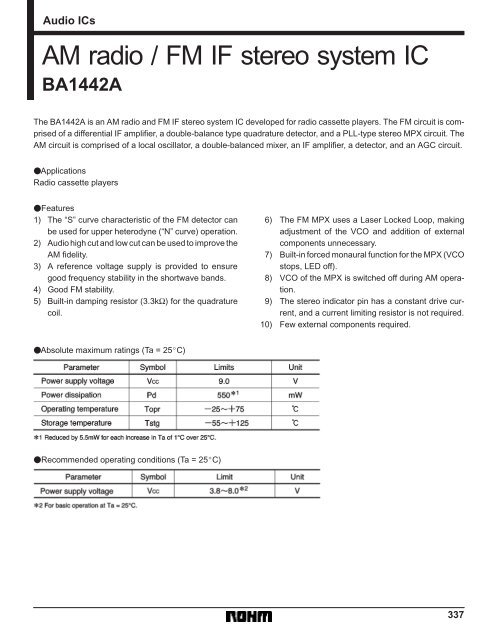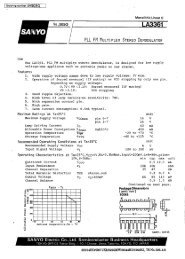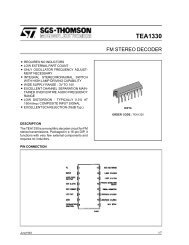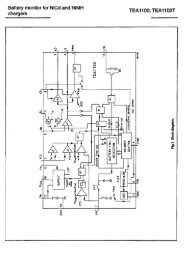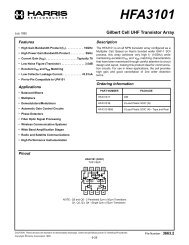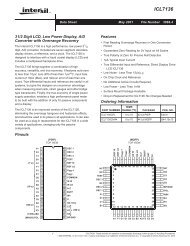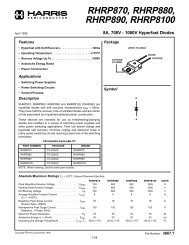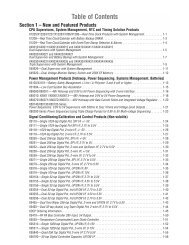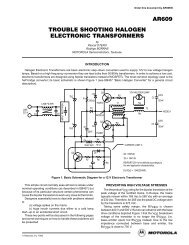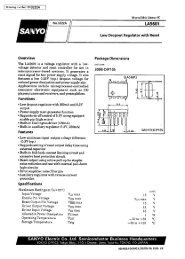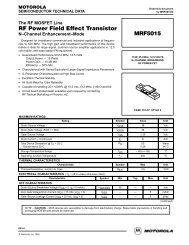AM radio / FM IF stereo system IC - ClassicCMP
AM radio / FM IF stereo system IC - ClassicCMP
AM radio / FM IF stereo system IC - ClassicCMP
Create successful ePaper yourself
Turn your PDF publications into a flip-book with our unique Google optimized e-Paper software.
Audio <strong>IC</strong>s<br />
<strong>AM</strong> <strong>radio</strong> / <strong>FM</strong> <strong>IF</strong> <strong>stereo</strong> <strong>system</strong> <strong>IC</strong><br />
BA1442A<br />
The BA1442A is an <strong>AM</strong> <strong>radio</strong> and <strong>FM</strong> <strong>IF</strong> <strong>stereo</strong> <strong>system</strong> <strong>IC</strong> developed for <strong>radio</strong> cassette players. The <strong>FM</strong> circuit is comprised<br />
of a differential <strong>IF</strong> amplifier, a double-balance type quadrature detector, and a PLL-type <strong>stereo</strong> MPX circuit. The<br />
<strong>AM</strong> circuit is comprised of a local oscillator, a double-balanced mixer, an <strong>IF</strong> amplifier, a detector, and an AGC circuit.<br />
Applications<br />
Radio cassette players<br />
Features<br />
1) The “S” curve characteristic of the <strong>FM</strong> detector can<br />
be used for upper heterodyne (“N” curve) operation.<br />
2) Audio high cut and low cut can be used to improve the<br />
<strong>AM</strong> fidelity.<br />
3) A reference voltage supply is provided to ensure<br />
good frequency stability in the shortwave bands.<br />
4) Good <strong>FM</strong> stability.<br />
5) Built-in damping resistor (3.3kΩ) for the quadrature<br />
coil.<br />
6) The <strong>FM</strong> MPX uses a Laser Locked Loop, making<br />
adjustment of the VCO and addition of external<br />
components unnecessary.<br />
7) Built-in forced monaural function for the MPX (VCO<br />
stops, LED off).<br />
8) VCO of the MPX is switched off during <strong>AM</strong> operation.<br />
9) The <strong>stereo</strong> indicator pin has a constant drive current,<br />
and a current limiting resistor is not required.<br />
10) Few external components required.<br />
Absolute maximum ratings (Ta = 25C)<br />
Recommended operating conditions (Ta = 25C)<br />
337
Audio <strong>IC</strong>s<br />
BA1442A<br />
Block diagram<br />
Pin descriptions<br />
338
Audio <strong>IC</strong>s<br />
BA1442A<br />
339
Audio <strong>IC</strong>s<br />
BA1442A<br />
340
Audio <strong>IC</strong>s<br />
BA1442A<br />
Electrical characteristics (unless otherwise noted, Ta = 25C, VCC = 5V, <strong>FM</strong> <strong>IF</strong> MPX: fin = 10.7MHz,<br />
400Hz modulation, 22.5kHz dev (30%), 19kHz 7.5kHz dev (10%)<br />
<strong>AM</strong>: fin = 1000kHz, fm = 400Hz 30%)<br />
Measurement circuit<br />
341
Audio <strong>IC</strong>s<br />
BA1442A<br />
Technical reference materials (unless otherwise noted, Ta = 25C and VCC = 5V)<br />
Circuit operation<br />
(1) The <strong>FM</strong> <strong>IF</strong> amplifier is a three-stage differential amplifier.<br />
The gain of this stage is approximately 60dB. The<br />
bias for the first-stage amplifier is taken from the bypass<br />
filter (pin 2). This improves the <strong>FM</strong> stability of the firststage<br />
amplifier by reducing noise. The input impedance<br />
is set by a resistor on the chip (330Ω), and can be connected<br />
to a ceramic filter.<br />
(2) The <strong>FM</strong> detector circuit is comprised of a quadrature<br />
detector. The <strong>IF</strong> amplified signal is input to the detector<br />
via a limiter amplifier with a gain of 13dB.<br />
(3) The <strong>AM</strong> mixer is a double-balance type, and has<br />
been designed for low local oscillator leakage. The mixer<br />
bias current is added from Vreg via antenna coil. If you<br />
lower the mixer conversion gain for mid- to high-strength<br />
electric fields, AGC will operate, and for high-strength<br />
electric fields, the input shunt AGC gives good strong-input<br />
characteristics.<br />
(4) The <strong>AM</strong> local oscillator circuit consists of a differential<br />
positive feedback loop. To improve the frequency stability,<br />
particularly in the SW band, the circuit is operated<br />
with bias referenced to Vreg. To improve the startup characteristics,<br />
a 100Ω resistor is inserted in series with the<br />
tank circuit.<br />
(5) The <strong>AM</strong> <strong>IF</strong> amplifier consists of two-stage differential<br />
amplifier. Both amplifiers use capacitors to block DC,<br />
so bypass capacitors are not necessary. The first stage<br />
amplifier has AGC. The gain of this stage is 47dB, and<br />
the input impedance is 3kΩ.<br />
(6) <strong>AM</strong> detector circuit<br />
A built-in envelope detector that uses a minute current<br />
serves as the <strong>AM</strong> detector. External components are not<br />
required.<br />
342
Audio <strong>IC</strong>s<br />
BA1442A<br />
(7) <strong>AM</strong> AGC circuit<br />
AGC is applied to the input shunt, mixer , and <strong>IF</strong> circuits.<br />
The AGC reduces the mixer and <strong>IF</strong> circuit current, and<br />
according the DC level of the detector output, reduces<br />
the gain to control the output at a fixed level. In addition,<br />
an input shunt is provided to prevent distortion caused by<br />
strong input signals. The AGC pin is also used as the<br />
MPX PLL filter pin. For this reason, when there is no input,<br />
the AGC voltage becomes Vreg (pin 19), and when<br />
there is a strong input signal, it is about Vreg - 0.2V.<br />
(8) <strong>AM</strong>/<strong>FM</strong> detector circuits<br />
There is one pin for both detector outputs (pin 6), and the<br />
<strong>AM</strong>/<strong>FM</strong> switching is done internally. The output impedance<br />
is 5kΩ, and the DC output is 1.3V.<br />
(9) The <strong>FM</strong> MPX circuit uses a PLL to recover the <strong>stereo</strong>.<br />
For <strong>FM</strong>, the input from pin 7 is switched by the decoder<br />
and output on pin 11 (L channel) and pin 12 (R<br />
channel). In the case of <strong>AM</strong>, the input is from pin 8, and<br />
this is output through to pins 11 and 12. The audio fidelity<br />
is improved by the low-pass filter comprised of the capacitor<br />
connected between pins 6 and 8 and the input impedance<br />
of pin 8 (20kΩ). The input/output gain for both <strong>AM</strong><br />
and <strong>FM</strong> is about 6dB. The VCO has been laser trimmed<br />
on the chip to set its time constant. External components<br />
and re-adjustment are not required.<br />
Application example<br />
343
Audio <strong>IC</strong>s<br />
BA1442A<br />
Frequency data<br />
Component data<br />
344
Audio <strong>IC</strong>s<br />
BA1442A<br />
345
Audio <strong>IC</strong>s<br />
BA1442A<br />
Selecting of attached components and operation notes<br />
Pin 1: <strong>FM</strong> ceramic filter (CF1)<br />
The input impedance of pin 1 is 330Ω, so it should be connected<br />
to a ceramic filter that has an output impedance<br />
of 330Ω. Connect the earth point of the ceramic filter to<br />
the input side GND. In addition, the connection distance<br />
between the ceramic filter and pin 1 should be as short<br />
as possible.<br />
Pin 2: <strong>FM</strong> <strong>IF</strong> bypass<br />
This pin is used to ensure stable <strong>FM</strong>, and it is normally<br />
connected to pin 19 (Vreg). If it is not possible to achieve<br />
stable <strong>FM</strong>, ground pin 2 via a 0.01µF capacitor. The earth<br />
point in this case will be on the GND side of the <strong>FM</strong> ceramic<br />
filter.<br />
Pin 3: Power supply bypass capacitors (C7 and C8)<br />
C7 should be a capacitor with good high-frequency characteristics.<br />
Connect it between the base of the legs of pin<br />
3 (VCC) and pin 5 (GND). The purpose of C8 is ripple rejectiun,<br />
and it can be connected a little further away.<br />
Pin 4: <strong>FM</strong> quadrature detector phase-shift coil (T3)<br />
Pin 3 and 4 are connected internally by a 3.3kΩ damping<br />
resistor. The earth point for the phase-shift coil should be<br />
VCC, so ensure that it is at the same voltage as pin 3 (VCC).<br />
Pin 6: <strong>FM</strong> detector low-pass filter capacitor (C11)<br />
This capacitor smooths the 2 10.7MHz (21.4MHz) signal<br />
generated by <strong>FM</strong> quadrature detection, and prevents<br />
leakage of the 10.7MHz signal. The output impedance of<br />
pin 6 (5kΩ) and C11 form a low-pass filter. Connect the<br />
earth point to a GND other than the input side GND. If you<br />
do not do this, the input carrier will return from the output,<br />
and may result in poor stability.<br />
If the capacitor is too large, poor separation will result.<br />
Pin 7: <strong>FM</strong> detector output coupling capacitor (C9)<br />
<strong>FM</strong> detector output is input to the MPX throngh C9. The<br />
input impedance of pin 7 (100kΩ) and C9 form a highpass<br />
filter. If the value of C9 is too low, poor bass region<br />
separation will result.<br />
Pin 8: <strong>AM</strong> detector output coupling capacitor (C10)<br />
<strong>AM</strong> detector output is input to the MPX through C10. The<br />
input impedance of pin 8 (20kΩ) and C10 form a high-pass<br />
filter and improves the <strong>AM</strong> fidelity. Characteristic curves<br />
for different values of C10 are given in the graph in Fig. 3.<br />
Pin 9: <strong>AM</strong> high-cut capacitor (C12)<br />
The input impedance of pin 9 (8kΩ) and C12 form a lowpass<br />
filter. To prevent beat from occurring between carrier<br />
leak from the detector output pin and the input signal,<br />
connect a capacitor of about 1000pF, even if not using<br />
high-cut. Connect the earth point to a GND other than the<br />
input side GND. Characteristic curves for different values<br />
of C12 are given in the graph in Fig. 4.<br />
346
Audio <strong>IC</strong>s<br />
BA1442A<br />
Pin 9: Forced monaural (SW1)<br />
If the voltage on pin 9 goes to 2.2V or higher in <strong>FM</strong> mode,<br />
forced monaural operation starts (VCO stops, the <strong>stereo</strong><br />
indicator goes off, and audio output goes monaural). Do<br />
not apply a voltage to pin 9 that is higher than the voltage<br />
on pin 3 (VCC). Also, when in <strong>AM</strong> mode, the <strong>AM</strong> detector<br />
output is output on pin 9, so use a switch to switch pin 9<br />
open circuit in <strong>AM</strong> mode, as shown in the application circuit<br />
example. If you change the voltage on pin 9 during<br />
<strong>AM</strong> operation, the AGC characteristics will be disturbed.<br />
Pin 10: Stereo indicator<br />
The pin 10 current is fixed at 10mA, so an external current-limiting<br />
resistor is not required. If you wish to reduce<br />
the brightness of the LED, connect a resistor in parallel<br />
to reduce the current. If you do not wish to use <strong>stereo</strong> indication,<br />
connect pin 10 directly to the power supply,<br />
however, the current consumption is that same as that<br />
when <strong>stereo</strong> indication is used. The withstanding voltage<br />
of pin 10 is 9V, so use caution when connecting it to power<br />
sources other than the <strong>IC</strong> power supply.<br />
Pin 14: PLL filter (C15, C16, and R4)<br />
PLL loop filter for the MPX. Varying the values of these<br />
components changes the capture range of the PLL, but<br />
can also result in PLL beat, or the PLL going out of lock<br />
due to temperature changes, so do not change these<br />
component values.<br />
Pin 15: Pilot filter and AGC filter (C17)<br />
Pin 15 is used by both the MPX pilot filter and the <strong>AM</strong><br />
AGC filter. Lower values for C17 will result in increased<br />
THD for bass-region <strong>AM</strong> audio, and larger values will increase<br />
the time required to switch between monaural<br />
and <strong>stereo</strong> for <strong>FM</strong>. Characteristic curves for various values<br />
of C17 are given in Figs. 7 to 9.<br />
Pins 11 and 12<br />
De-emphasis capacitors (C13 and C14)<br />
The output impedance of pins 11 and 12 (5kΩ), and C13<br />
and C14 set the de-emphasis time constant (50µsec. for<br />
0.01µF, and 75µsec. for 0.015µF). Do not connect C13<br />
and C14 if composite (voice multiplex etc.) signal processing<br />
will be performed at the following stage.<br />
Pin 13: <strong>AM</strong>/<strong>FM</strong> switching noise reduction filter<br />
Pin 13 is the <strong>AM</strong> power supply pin. When power is applied,<br />
the circuit is in <strong>AM</strong> mode. By setting a CR time<br />
constant, it is possible to reduce the audible switching<br />
noise that occurs when switching between <strong>AM</strong> and <strong>FM</strong>.<br />
Choose the resistor so that the voltage drop across the<br />
resistor is 0.5V max. with respect to the pin 3 (VCC). Do<br />
not apply a voltage higher than the voltage on pin 3 (VCC)<br />
to pin 13.<br />
347
Audio <strong>IC</strong>s<br />
BA1442A<br />
Pin 18: <strong>AM</strong> antenna (L3)<br />
The input impedance of pin 18 is 10kΩ. The <strong>AM</strong> antenna<br />
earth point is Vreg; make the voltage at pin 18 the same<br />
as the pin 19 (Vreg) potential. If there is a voltage drop,<br />
local oscillator leakage to the mixer output will increase.<br />
Pin 19: Reference power supply bypass capacitors (C18<br />
and C19)<br />
Connect the low-frequency bypass capacitor (C18) and<br />
the high-frequency bypass capacitor (C19).<br />
Pin 20: <strong>AM</strong> oscillator coil (L4)<br />
To improve the startup oscillation characteristics, a 100Ω<br />
resistor (built-in) is connected in series with the coil. If the<br />
shortwave oscillation startup characteristics are poor,<br />
connect an additional resistor (47Ω to 100Ω) in series<br />
with the coil. Make the earth point for the oscillator coil pin<br />
19 (Vreg). The relationship between the S/N ratio and<br />
sensitivity at 20dB S/N against pin 20 oscillation voltage<br />
is shown in Fig. 11.<br />
Pin 16: <strong>AM</strong> ceramic filter (CF2)<br />
The input impedance of pin 16 is 3kΩ, so it should be connected<br />
to a ceramic filter that has an output impedance<br />
of 3kΩ. The connection distance between the ceramic filter<br />
and pin 16 should be as short as possible.<br />
Pin 17: <strong>AM</strong> <strong>IF</strong>T (T2)<br />
The output impedance of pin 17 is 100kΩ. The <strong>IF</strong>T earth<br />
point is VCC; make the voltage at pin 17 the same as the<br />
pin 3 (VCC) potential. The connection distance between<br />
the <strong>IF</strong>T and pin 17 should be as short as possible.<br />
348
Audio <strong>IC</strong>s<br />
BA1442A<br />
Pin 6: AFC circuit<br />
It is possible to use the pin 6 detector output DC voltage<br />
and apply AFC. Fig. 12 shows an application example<br />
where the BA4424N is used as the <strong>FM</strong> front end.<br />
Even if you will not use AFC, when recovering the subcarrier<br />
phase-modulated composite signal (voice-multiplexed<br />
TV) in the next stage, match the oscillator and “S”<br />
curve orientations in the same way as described above.<br />
If they are reversed, the left and right channels of the recovered<br />
audio will be reversed.<br />
349
Audio <strong>IC</strong>s<br />
BA1442A<br />
Quiescent pin voltages (VCC = 5V)<br />
Electrical characteristic curves<br />
MW characteristics<br />
350
Audio <strong>IC</strong>s<br />
BA1442A<br />
<strong>FM</strong> characteristics<br />
351
Audio <strong>IC</strong>s<br />
BA1442A<br />
Application board<br />
352
Audio <strong>IC</strong>s<br />
BA1442A<br />
External dimensions (Units: mm)<br />
353


